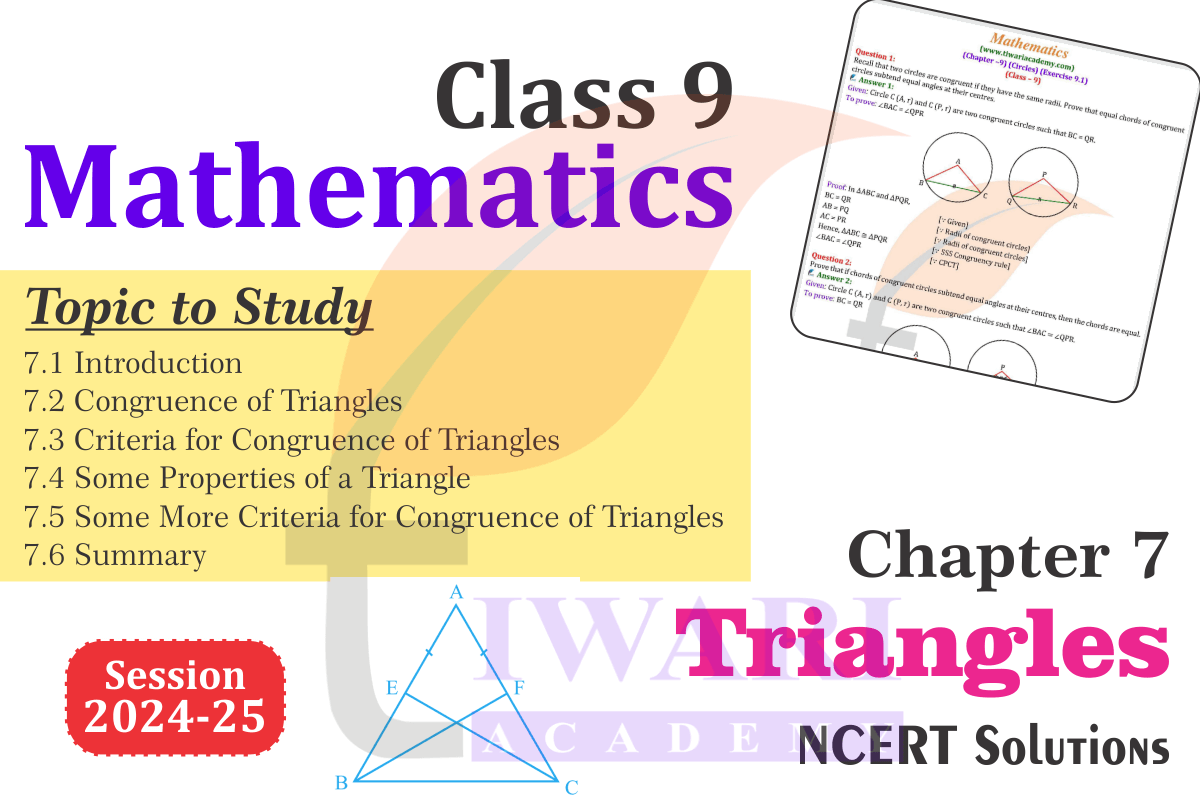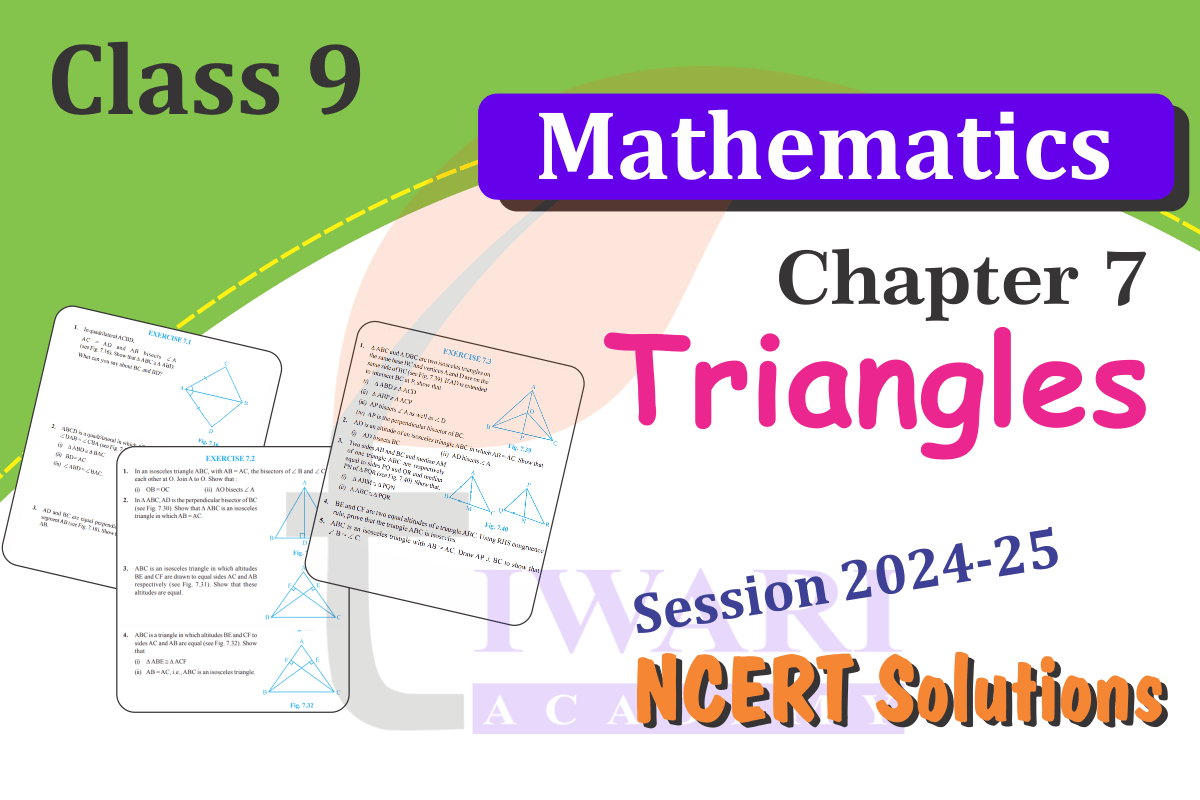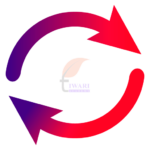NCERT Solutions for Class 9 Maths Chapter 7 Triangles all exercises in English Medium and Hindi Medium updated for new academic session 2025-26. As per the new revised syllabus, there are only three exercises in latest NCERT books for CBSE 2025-26. NCERT Updated Solutions for Class 9 Mathematics Chapter 7 Triangles provide a comprehensive guide to mastering the concepts of this fundamental geometry topic. Covering exercises like NCERT Class 9 Math Book Chapter 7 Exercise 7.1 and Exercise 7.2, these solutions are essential for understanding the properties of triangles, including congruence criteria and inequalities. With PDF resources readily available, students can download Class 9 NCERT Maths Chapter 7 Assignment Solutions for offline study.
Class 9 Maths Chapter 7 Solutions: CBSE Board
For those studying in Hindi, NCERT Complete Solutions for Class 9th Mathematics Chapter 7 in Hindi offer a localized approach to grasping the same concepts effectively. NCERT 9th Math chapter 7 also includes detailed explanations for exercises like Triangles Chapter Class 9 Maths Book Exercise 7.3, making it easier for students to clarify doubts. Important questions and notes for 9th Mathematics Chapter 7 are especially helpful for revision before exams, ensuring a solid foundation in the subject.
Class 9 Maths Exercise 7.1 in English
Class 9 Maths Exercise 7.2 in English
Class 9 Maths Exercise 7.3 in English
NCERT Class 9 Mathematics Textbook Chapter 7 Solutions are designed to help students approach triangles systematically. NCERT Book Exercises such as Class 9 Maths Chapter 7 Exercise 7.4 and CBSE Math Exercise 7.5 cover advanced applications of triangle properties, making the subject more engaging. Students can find resources like Triangles Class 9 NCERT Math Solutions PDF Download to prepare effectively. For Hindi medium learners, Triangles Chapter 7 Maths Class 9 Solutions in Hindi include step-by-step answers for better comprehension.
Class 9 Maths Chapter 7 Solutions: State Boards
Whether it is Class 9th NCERT Math Book Chapter 7 Important Questions or notes, these resources simplify complex problems. The NCERT Exercise Class 9 Mathematics Chapter 7 Solutions PDF is a must-have for those who prefer studying digitally. Exercises like Class 9 Maths Chapter 7 Exercise 7.2 PDF Solutions ensure students have ample practice, building their confidence for tackling both theoretical and numerical problems.
Class 9 Maths Chapter 7 Exercise 7.1
Class 9 Maths Chapter 7 Exercise 7.2
Class 9 Maths Chapter 7 Exercise 7.3
Class 9 Maths Chapter 7 Exercise 7.4
Class 9 Maths Chapter 7 Exercise 7.5
NCERT Solutions for Class 9 Maths Chapter 7
The Triangles Chapter 7 Class 9 NCERT Mathematics Solutions not only cover textbook exercises but also provide additional support through practice questions and notes. Resources like Class 9 Maths NCERT Book Chapter 7 PDF are crucial for quick access during revisions. Exercises such as NCERT Textbook Solutions for Class 9 Maths Chapter 7 Exercise 7.4 in Hindi cater specifically to Hindi medium students. Additionally, Class 9 Maths Chapter 7 Exercise 7.1 and Exercise 7.3 offer ample examples to reinforce concepts like the Pythagoras theorem and triangle inequalities. Students can access these solutions both online and offline, with PDFs available for download. The Math Triangles Chapter 7 Class 9 NCERT Detailed Solutions in Hindi further enhance learning by presenting the subject matter in a relatable language.
Class 9 Maths Chapter 7 Solutions: Hindi Medium
These tools, along with Class 9 Maths Chapter 7 Notes and Important Questions, are invaluable for acing exams and building a strong geometry foundation. In addition to solutions, Tiwari Academy may offer a wide range of practice problems and exercises related to each topic. This gives students ample opportunities to practice and apply what they’ve learned, which is essential for improving problem-solving skills.
Class 9 Maths Exercise 7.1 in Hindi
Class 9 Maths Exercise 7.2 in Hindi
Class 9 Maths Exercise 7.3 in Hindi
| Class: 9 | Mathematics |
| Chapter: 7 | Triangles |
| Number of Exercises: | 3 (Three) |
| Content Type: | Text and Videos |
| Academic Session: | CBSE 2025-26 |
| Medium: | English and Hindi Medium |
Important Points in Class 9 Maths Chapter 7 for Exams
Triangle Congruence Criteria: SSS, SAS, ASA, AAS and RHS.
Properties of triangles, including inequalities and the angle sum property.
Pythagoras theorem and its applications.
Proof-based questions on congruence.
Focus on exercises like 7.1 to 7.5 for thorough practice.
| Day | Topic | Tasks | Remarks |
|---|---|---|---|
| Day 1 | Triangle Basics | Review definitions, properties, and types of triangles. Solve Exercise 7.1. | Focus on understanding fundamental concepts. |
| Day 2 | Congruence of Triangles | Study SSS, SAS, ASA, AAS and RHS criteria. Solve Exercise 7.2. | Memorize congruence criteria. |
| Day 3 | Properties of Triangles | Learn angle sum property and triangle inequalities. Solve Exercise 7.3. | Focus on proof-based questions. |
| Day 4 | Pythagoras Theorem | Understand the theorem and solve related problems from Exercise 7.4. | Practice diagram-based questions. |
| Day 5 | Revision and Practice | Revise important questions and complete Exercise 7.5. | Identify weak areas and revise again. |

According to Utter Pradesh Board (Prayagraj) students of class 9 will use NCERT Books for 9th Maths as course books. So, UP Board Solutions for Class 9 Maths Tribhuj ki Prashnavali 7.1, Prashnavali 7.2 and Prashnavali 7.3 in Hindi Medium PDF format are given to free download for academic session 2025-26. NCERT Solutions (https://ncert.nic.in/) in Hindi Medium and English Medium or View in Video Format, for the students studying NCERT Books 2025-26, are based on the CBSE Curriculum 2025-26. Questions and solutions of all the five exercise of 9th Maths Chapter 7 are given below. Steps for solving questions are described properly by subject experts. Easy and simplified solutions are given, so that student can understand easily.
9th Maths Chapter 7 Solutions in English & Hindi Medium
NCERT Solutions for class 9 Maths chapter 7 all exercises in English & Hindi medium free download for session 2025-26. Download UP Board App Apk and NCERT Solutions Offline Apps updated on the basis of NCERT Books free to use offline.

Class 9 Maths Chapter 7 Practice Question with Solution
What are the properties of a Triangle?
Properties of a Triangle
1. Angle opposite to equal sides of an isosceles triangle are equal.
2. The sides opposite to equal angles of a triangle are equal.
3. If two sides of a triangle are unequal then the angle opposite to the longer side is larger.
4. In any triangle, the side opposite to the larger angle is larger.
5. The sum of any two sides of a triangle is greater than the third side.
6. The difference between any two sides of a triangle is less than its third side.
7. If the bisector of the vertical angle of a triangle bisects the base, then triangle is an isosceles triangle.
8. The sum of any two sides of a triangle is greater than twice the median drawn to the third side.
Define a Triangle.
Triangle: A plane figure closed by three intersecting lines is called a triangle. Here, ‘Tri’ means THREE. A triangle has three sides, three angles and three vertices.
Important Notes on 9th Maths Chapter 7
Rules for Congruence of Triangle: Two triangles are congruent, if sides and angles of one triangle are equal to the corresponding sides and angles of the other triangle.
SSS (Side – Side – Side) Congruence Rule: Two triangles are congruent, if three sides of one triangle are equal to three sides of the other triangle.
RHS (Right angle – Hypotenuse – Side) Congruence Rule: Two right triangles are congruent, if the hypotenuse and one side of one triangle are equal to hypotenuse and one side of the other triangle.
ASA (Angle – Side – Angle) Congruence Rule: Two triangles are congruent, if two angles and the included side of one triangle are equal to two angles and the included side of the other triangle.
SAS (Side – Angle – Side) Congruence Rule: Two triangles are congruent, if two sides and the included angle of one triangle are equal to two sides and the included angle of the other triangle.
Important Questions on 9th Maths Chapter 7
ABC is a triangle. Locate a point in the interior of ΔABC which is equidistant from all the vertices of ΔABC.
Draw perpendicular bisectors of AB, BC and AC, which intersects each other at G. Point G is equidistant from the three vertices of ΔABC.
In a triangle locate a point in its interior which is equidistant from all the sides of the triangle.
Draw the bisectors of ∠A, ∠B and ∠C, which intersect each other at O. Point O is equidistant from the three sides of ΔABC i.e. OP = OQ = OR.
AD is an altitude of an isosceles triangle ABC in which AB = AC. Show that AD bisects BC.
In ΔABD and ΔACD, ∠ADB = ∠ADC [∵ Each 90°] AB = AC [∵ Given] AD = AD [∵ Common] Hence, ΔABD ≅ ΔACD [∵RHS Congruency Rule] BD = DC [∵ CPCT] Hence, AD bisects BC
ABC is an isosceles triangle with AB = AC. Draw AP ⊥ BC to show that ∠B = ∠C.
In ΔABP and ΔACP, ∠APB = ∠APC [∵ Each 90°] AB = AC [∵ Given] AP = AP [∵ Common] Hence, ΔABP ≅ ΔACP [∵RHS Congruency Rule] ∠B = ∠C [∵ CPCT]
Class 9 Maths Chapter 7 Exercise 7.1 Solution in Videos
Need of NCERT Solutions for Class 9 Maths Chapter 7 Triangles
The NCERT Textbook Solutions for Class 9 Maths Chapter 7 Triangles provide step-by-step explanations for all exercises in the chapter, such as NCERT Book Exercise 7.1, CBSE Textbook Exercise 7.2 and Complete Exercise 7.3. These solutions help students understand key concepts like triangle congruence criteria, inequalities and the Pythagoras theorem. Available as Class 9 Maths Chapter 7 PDF, these resources are easily downloadable for offline use. NCERT Solutions for Class 9 Mathematics Chapter 7 in Hindi are offered for Hindi medium learners. With practice questions, notes and Class 9 Maths Chapter 7 Important Questions, these solutions are perfect for exam preparation and conceptual clarity.
NCERT Solutions for Class 9 Maths Chapter 7 available in Hindi
NCERT Solutions for Class 9 Maths Chapter 7 in Hindi are available for Hindi medium learners at Tiwari Academy. These solutions provide localized step-by-step explanations for exercises such as NCERT Exercise 7.1 and CBSE Textbook Exercise 7.2, making them easier to understand. The Triangles Chapter Class 9 Solutions in Hindi also include notes, important questions and additional examples for practice. PDFs, such as Class 9 Maths Chapter 7 PDF, can be downloaded for offline study. These resources cater specifically to Hindi-speaking students, helping them grasp difficult concepts from Class 9 Maths Chapter 7 Solutions with ease and confidence.
Where can I download NCERT Solutions for Class 9 Maths Chapter 7?
Students can download Class 9 Maths Chapter 7 Textbook Solutions in PDF format from reliable educational websites like Tiwari Academy. These PDFs include answers to exercises like Class 9 Maths Chapter 7 Exercise 7.4 and Optional Exercise 7.5, covering advanced concepts in the chapter. For Hindi medium learners, Triangles Chapter Class 9 Solutions in Hindi are also available for download. These resources are essential for revisions, allowing students to solve important questions and review Class 9 Maths Chapter 7 Notes anytime. Triangles Class 9 NCERT Solutions PDF Download ensures that students have access to accurate and detailed solutions, even offline.
What are the main points of chapter 7 of class 9th Maths that students must remember at the exam time?
The main points of chapter 7 of class 9th Maths that students must remember at the time of exam are:
- Two figures are congruent, if they are of the same shape and of the same size.
- If two triangles ABC and PQR are congruent under the correspondence A ↔ P, B ↔ Q and C ↔ R, then symbolically, it is expressed as ∆ ABC ≅ ∆ PQR.
- If two sides and the included angle of one triangle are equal to two sides and the included angle of the other triangle, then the two triangles are congruent (SAS Congruence Rule).
- If two angles and the included side of one triangle are equal to two angles and the included side of the other triangle, then the two triangles are congruent (ASA Congruence Rule).
- If two angles and one side of one triangle are equal to two angles and the corresponding side of the other triangle, then the two triangles are congruent (AAS Congruence Rule).
- Angles opposite to equal sides of a triangle are equal.
- Sides opposite to equal angles of a triangle are equal.
- If three sides of one triangle are equal to three sides of the other triangle, then the two triangles are congruent (SSS Congruence Rule).
- If in two right triangles, hypotenuse and one side of a triangle are equal to the hypotenuse and one side of other triangle, then the two triangles are congruent (RHS Congruence Rule).
- In a triangle, angle opposite to the longer side is larger (greater).
- In a triangle, side opposite to the larger (greater) angle is longer.
- Sum of any two sides of a triangle is greater than the third side.
What is covered in Class 9 Maths Chapter 7 Important Questions?
Class 9 Maths Chapter 7 Important Questions focus on essential topics such as triangle congruence criteria, inequalities and the Pythagoras theorem. These questions are designed to strengthen problem-solving skills and prepare students for exams. Included in resources like NCERT Class 9 Mathematics Chapter 7 Solutions PDF, these questions ensure a thorough understanding of the chapter. Exercises like Class 9 Maths Chapter 7 NCERT Exercise 7.3 and Detailed Exercise 7.4 provide ample practice. Triangles Chapter Class 9 Math Solutions in Hindi include the same important questions, making them accessible for Hindi medium learners. These questions are ideal for revision and mastering key concepts.
Does chapter 7 of grade 9th Maths contain any optional exercise? If yes, which exercise of chapter 7 is optional?
As per the new syllabus, the chapter 7 of grade 9th Maths contains no optional exercise. Earlier, there were five exercises in chapter 7 and the last exercise (Exercise 7.5) was the optional one. Now there are only three exercises in course and all are important for examination point of view.
How do NCERT Solutions for Class 9 Maths Chapter 7 help in exam preparation?
NCERT Solutions for Class 9 Maths Chapter 7 Triangles are a valuable tool for exam preparation. They offer detailed answers to exercises like Exercise 7.1 and Optional Exercise 7.5, covering the entire chapter. Resources such as Class 9 Maths Chapter 7 Notes, Important Questions and Class 9 Maths Chapter 7 PDF simplify revisions. For Hindi medium students, NCERT Solutions for Class 9 Maths Chapter 7 in Hindi provide easy-to-follow explanations. With solutions for exercises like Triangles Class 9 NCERT Solutions PDF Download, students can practice and revise effectively. These resources enhance problem-solving skills and boost confidence for exams.
Is chapter 7 Triangles of class 9th Maths easy or difficult to solve?
Chapter 7 of class 9th Maths is not easy and not difficult. It lies in the middle of easy and difficult because some examples and questions of this chapter are easy, and some are complicated. However, the difficulty level of any topic varies from student to student. So, Chapter 7 of class 9th Maths is easy or not depends on students also. Some students find it difficult, some find it easy, and some find it in the middle of easy and tough.
What are the real-life examples of congruent shapes in 9th Maths Chapter 7?
Some real-life examples of congruent shapes are:
- Pair of earrings.
- Pages of the same book.
- Biscuits of the same packs.
- Two bangles of the same radii.
- Two square sheets of the same sides.


